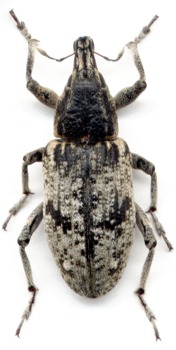Pests
Asproparthenis punctiventris Germar - Sugar Beet Weevil (Gray Weevil).
Systematic position.
Class Insecta, Order Coleoptera, Family Curculionidae, Genus Asproparthenis Gozis. 4 subspecies: A. punctiventris punctiventris Germ., A. punctiventris nubeculosus Gyll., A. punctiventris farinosus Fahr., A. punctiventris carinifer Fahr. are included into A. punctiventris species. Coexist together with A. foveicollis Gebl., which differs in bilobate scales on elytra. Closely related to A. securus Fst., which is known from Chita Region, Buryatia, Mongolia and China.Synonyms.
Asproparthenis Gozis (=Epimeces Billberg; Bothynoderes Schoenherr, auct.). A. punctiventris punctiventris Germ. (=A. stigma Strm.; A. uniformis Chevr.; A. betavorus Chevr.); A. punctiventris nubeculosus Gyll. (=A. caucasicus Chevr.; A. duplicarina Chevr.); A. punctiventris farinosus Fahrs. (=A. irroratus Men.; A. lineiventris Chevr.).Biological group.
Pests of sugar beet.Morphology and biology.
Body length, 14.5-17 mm. Rostrum narrowed to apex, 2nd segment of flagellum distinctly longer than first one. Rostral dorsum with median carina and longitudinal furrow on each side. Body covered with light gray vestiture, 4-lobed scales prevail on elytra. Apex of aedeagus is widely rounded. Mating continues from the second half of April to the end of May, and oviposition from the end of April to June and later. Females lay yellowish-white eggs near host plants under the surface of the soil; fertility is not more than 750 eggs. Eggs develop 5-12 days. Usually larvae lie down at a depth near 10-30 cm, eating longitudinal cavities on crop roots. Larvae develop in 45-90 days, having 5 instars. Body length of the last instar larva is 27-30 mm. Pupation occurs in vertical soil cradles at a depth of 10-15 cm and continues to late autumn. The pupa develop in 2-2.5 weeks. Adults hibernate in soil cradles, diapausing sometimes during 2 years.Distribution.
Inhabits steppe and forest-steppe regions of Eurasia at latitudes from 52-54° N to 30° N and longitudes from 0° E to 105° E. In the former USSR it is widely distributed in the traditional beet-growing area of Ukraine, Central Chernozem Region of Russia, Rostov Region, and Krasnodar Territory.Ecology.
In the wild it is common in areas along seacoasts, around salinas and firths, occurring on Atriplex tataricum, A. laciniatum, Chenopodium sp. and rarer on Polygonum aviculare, Amaranthus retroflexus, Suaeda sp. Spring activity of the beetle starts when average surface soil temperature reaches 7-8°C. Flight begins when average air temperature reach 18-20°C. Adults need additional feeding before reproduction. Population density in nature depends on the activity of entomophages, e.g., parasites of adult beetles such as Rondaria dimidiata Meig.,and parasites of eggs, such as Caenocrepis bothynoderi Grom. Numerous larvae and pupae may be infected during cold summers by Metarrhizium anisopliae (Metsch.).Economic significance.
In the former USSR the Sugar Beet Weevil is most harmful in the European part. Adults devour beet sprouts, especially during dry and hot springs. Early and synchronous beet sprouts are not strongly damaged by the pest. Control measures also include thorough soil treatment and insecticides.Related References:
Alonso-Zarazaga M.A. 1999. A world catalogue of families and genera of Curculionoidea (Insecta, Coleoptera). Entomopraxis, S.C.P. Edition. Barcelona. - 315 p.Luk'yanovich Th.K. 1958. A contribution to the biology, geographical and systematics of the species of the subgenus Bothynoderes Schonh. s. str. (Coleoptera, Curculionidae). Entomol. obozr. V. 37 (1). - P. 105-123 (in Russian).
Shchegolev V.N. (Ed.). 1955. Agricultural Entomology. Leningrad & Moscow: Gos. Izd. Selskokhoz. Lit. - 616 p. (in Russian).
Ter-Minasyan M.E. 1958. Review of the species of the subgenus Bothynoderes Germ. s. str. (Coleoptera, Curculionidae). Entomol. obozr. V. 37 (1). - P. 124-131 (in Russian).
Ter-Minasyan M.E. 1988. The weevils of the subfamily Cleoninae of the fauna of USSR. Leningrad: Nauka. - 233 p. (in Russian).


